What: A manuscript including the life of the saints Maba’a Seyon and Gabra Krestos. Previously owned by Lady Meux. The British Museum’s E. A. Wallis Budge said the coloured images were “of special interest as they portray events in the daily life of the modern Abyssinians”.
Where: Unknown
One of four beautifully illustrated Magdala manuscripts that went on their own amazing journey after the Abyssinian campaign.
In brief, they were brought back from the battle by an unnamed British officer and put on sale by the antiquarian book dealer Bernard Quaritch in London. The British Museum didn’t have enough money so they were bought by the eccentric Lady Meux (formerly a banjo-playing barmaid named Val), who ran her own private museum in Hertfordshire.
She spent vast sums producing coloured reproductions of the manuscripts, made contacts with the Ethiopian royal family and, in her will, left them to Emperor Menelik II. But her will was ignored and the manuscripts were sold on – one to the U.S. newspaper magnate (and Citizen Kane inspiration) William Randolph Hearst. That manuscript has ended up in the Schøyen manuscript collection which is spread across Oslo and London. Another is in the Chester Beatty Library in Dublin. The other two – a rare copy of the Life of Mary’s mother Hanna and this manuscript – are still missing. See a more detailed version of the story of the Lady Meux collection at the bottom of this page.
Before it disappeared, this manuscript was reproduced and translated in Budge’s limited edition book The lives of Mabâ’ Seyôn and Gabra Krĕstôs: The Ethiopic texts edited with an English translation and a chapter on the illustrations of Ethiopic mss. London: W. Griggs.
See the whole book here: https://archive.org/details/b28037650/mode/2up
Here are some of the reproductions of images from the missing manuscript. get in touch if you recognise them in a library near you.
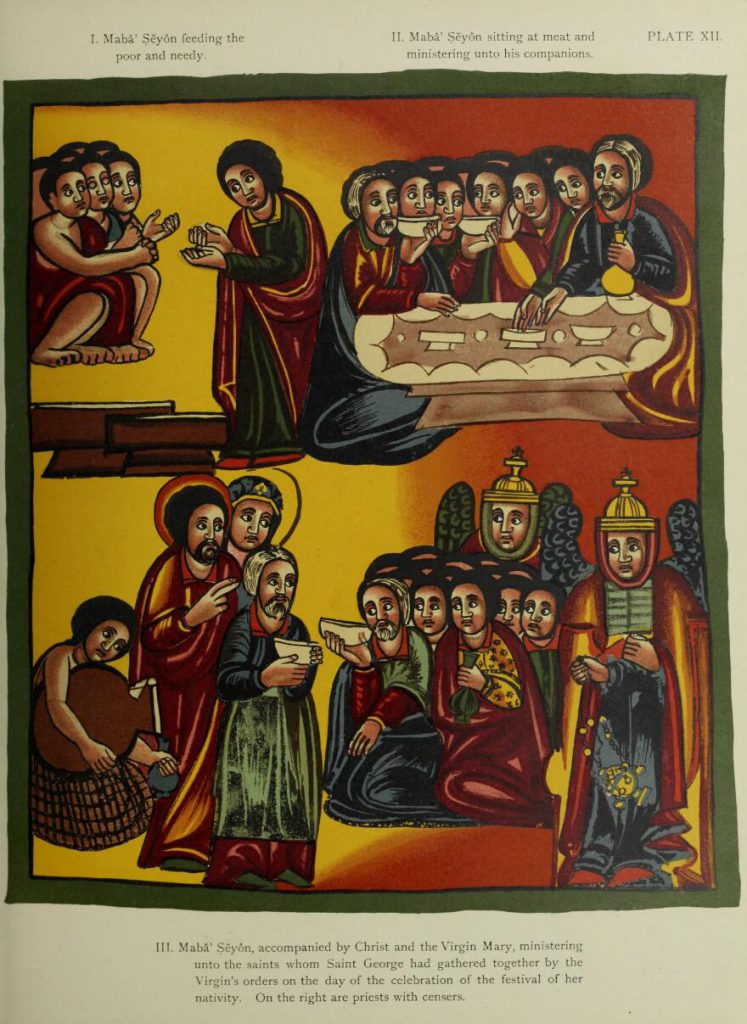
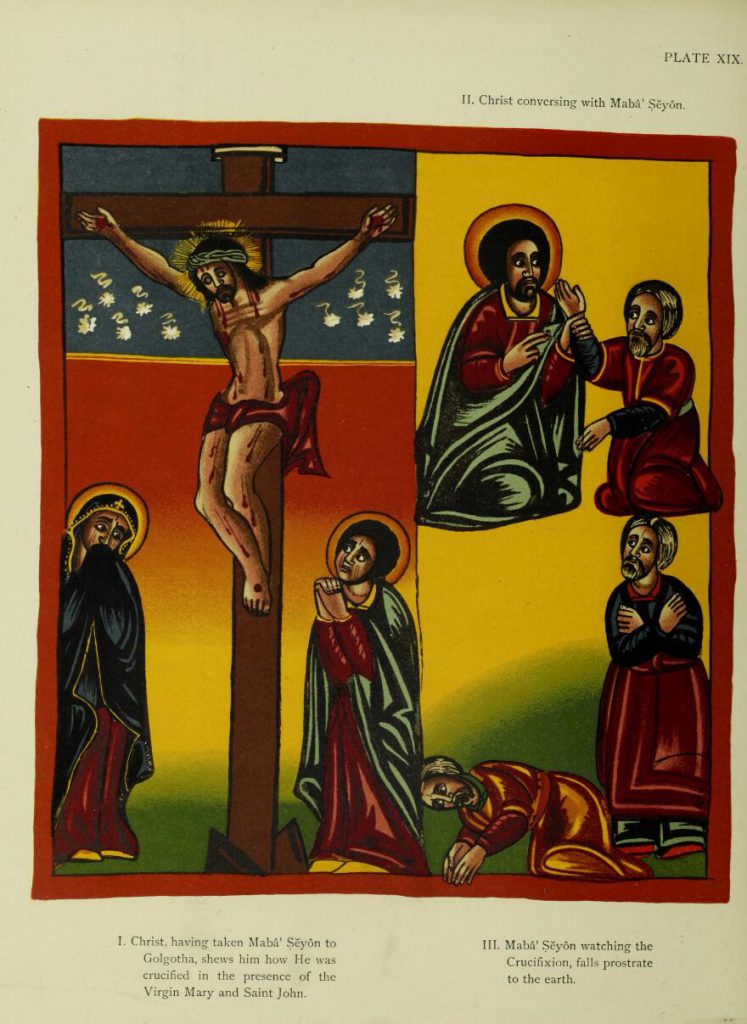
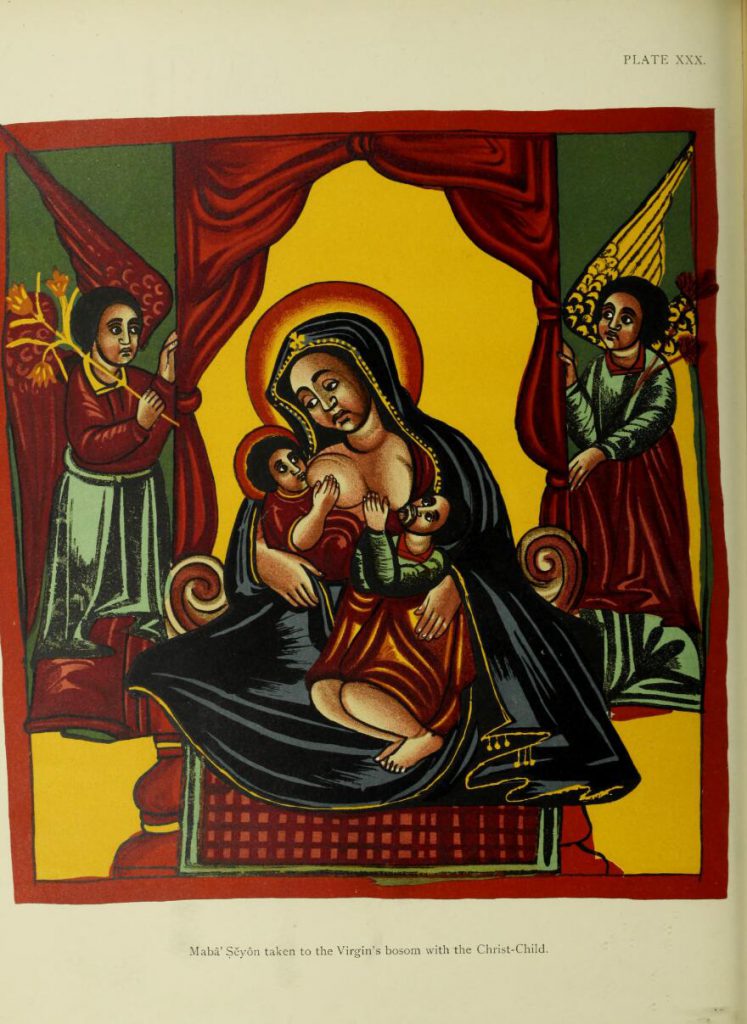
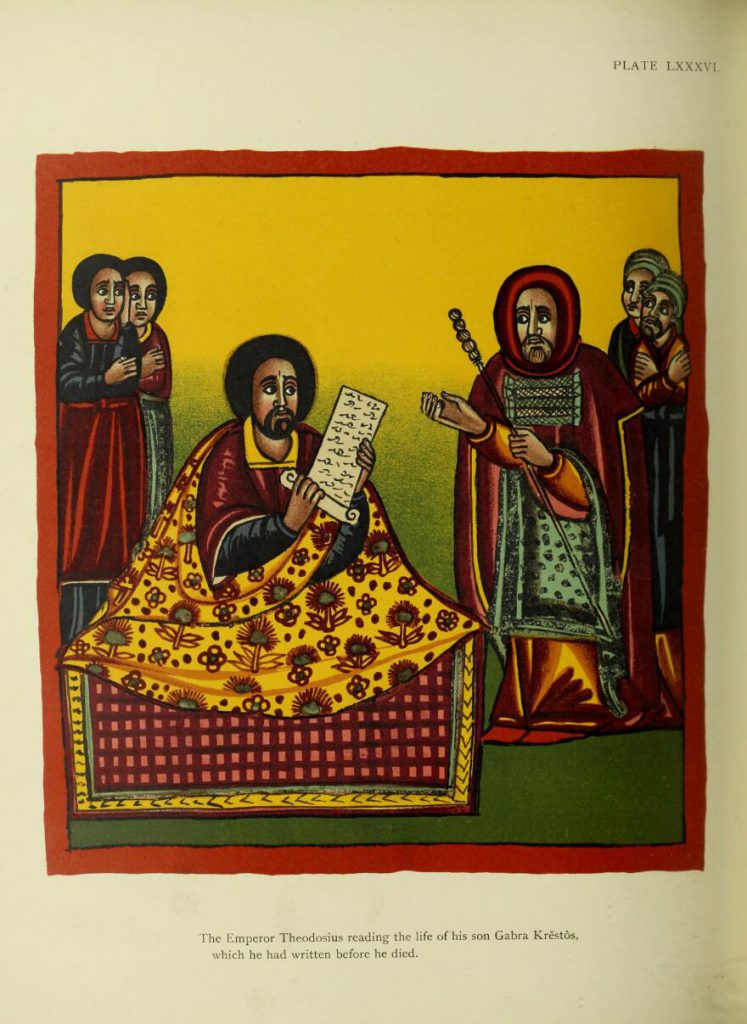
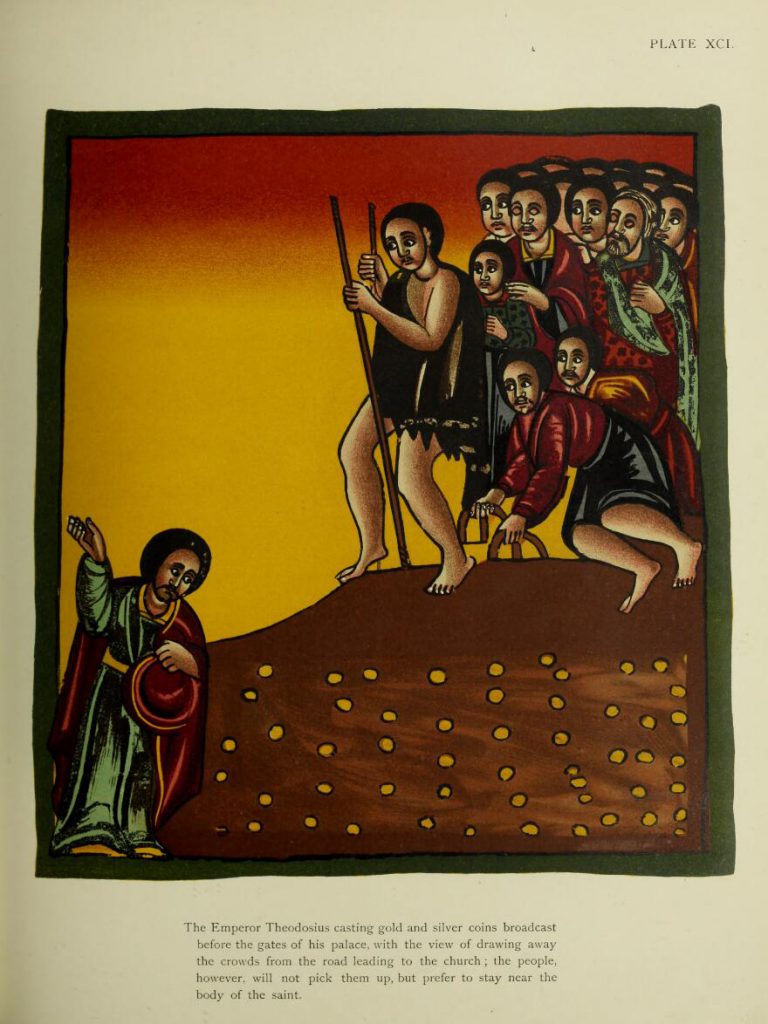
The story of the Meux collection
From the Preface to E. A. Wallis Budge’s Legends of Our Lady Mary the perpetual virgin and her mother Hannâ:
“In the spring of 1897 Lady Meux went to the establishment of Mr. Bernard Quaritch in Piccadilly to purchase a copy of Ludolf’s “Historia AEthiopica.” Finding that she had been reading a translation of the Ethiopic Version of the History of Alexander the Great, he took the opportunity of showing her a group of fine Ethiopic MSS., which he had recently acquired from an officer who had served in the British Expedition to Abyssinia in 1867. She telegraphed to me asking me to go and examine the manuscripts and to report upon them to her without delay. I did so, and Mr. Quaritch put the manuscripts before me. The oldest of them was a small 4to volume containing a Life of Hanna, the mother of the Blessed Virgin Mary; it was illustrated with archaic Ethiopian pictures of Hanna and her husband Joachim, the Birth of the Virgin, etc., and was written in the XVth century. It was, and still is the only copy of the Life of Hanna in Ethiopia known to me. Two of the manuscripts were large handsome volumes about 16 inches square, and each contained a good selection of the Miracles of the Virgin Mary, illustrated with many full-page pictures painted in bright colours which were intended to illustrate the texts of the Miracles. The older of these MSS. was written in the XVIth century and the other about a century later ; each had been made for the use of a royal personage. Another manuscript contained the Life of Maba’a Seyon, a comparatively modern Ethiopian saint, and the Life of Gabra Krestos, a prince who abandoned his royal state and home and parents, and became a mendicant monk. These Lives were illustrated by a large series of coloured pictures, which are of special interest as they portray events in the daily life of the modern Abyssinians. I sent to Lady Meux a description of these MSS., pointing out their interest and importance, and their great value from an artistic point of view. I also told the Keeper of Oriental Manuscripts in the British Museum of them, and urged him to attempt to acquire them for the National Collection. But his official financial position was such that it was impossible for him to make an offer for them which Mr. Quaritch would accept, and so the whole group of MSS., together with a few smaller works, became the property of Lady Meux, who added them to her Col- lection of Egyptian and Sudani antiquities preserved in the museum at Theobalds Park…
“… But to return now to the manuscripts that Lady Meux had purchased from Mr. Quaritch. As soon as these were delivered to her she asked me to make a fuller examination of them, and to describe their contents more or less in detail, so that she might come to some decision as to their publication. She had already published for private circulation the Ethiopic Version of the History of Alexander the Great, which I had copied and translated from MSS. in the British Museum, and the very favourable reception which this work met with at the hands of scholars and the literary world in general stimulated her to continue the publication of Ethiopic texts with English translations. And this version of the famous Alexander Book was welcomed in Ethiopia and praised by no less a critic than His Majesty the Lion of the Tribe of Judah, Menyelek II, King of the Kings of Ethiopia. When the British Mission to Menyelek was received by the King in Addis Abbeba, Sir F. R. Wingate presented to His Majesty, with the other gifts, a copy of the “Life and Exploits of Alexander the Great,” which Lady Meux had sent him. And I was told by a member of the Mission that His Majesty was both surprised and pleased with the Ethiopic text, which he began to read forthwith, and that he admired the Ethiopic type and wished to have more books of the kind produced.
“Of the Lady Meux MSS. the first to be reproduced was that containing the Lives of Maba’a Seyon and Gabra Krestos, a stout quarto leather-bound volume containing ninety-two pictures illustrating the text. The coloured facsimiles of the pictures were reproduced by the late Mr. W. Griggs and were inserted in their proper places in the English text. The Ethiopic texts were printed by the eminent German firm of W. Drugulin of Leipzig because the necessary fount of type did not exist in England, and were placed at the end of the book. Up to that time hardly any attention had been paid by scholars to the art exhibited by the pictures in the illustrated manuscripts, and some of them went so far as to describe it as “wretched caricature,” and the pictures as “horrible daubs.” …
“The volume containing the Lives of Maba’a Seyon and Gabra Krestos appeared in the summer of 1898, and was so warmly welcomed by scholars and learned societies that Lady Meux decided to reproduce the Miracles of the Virgin and the Life of Hanna, etc., without delay. This work occupied nearly two years, and the new volume, containing Ethiopic texts, English translations and one hundred and eleven coloured plates, appeared in 1900 …
“Lady Meux distributed the volume among scholars and Libraries where it would be easily accessible for study, and her generosity was greatly appreciated … Mr. (now Sir) J. L. Harrington, H.B.M.’s Minister Plenipotentiary to the Court of the Emperor Menyelek, presented a copy of the work to His Majesty, who was apparently greatly pleased with the gift. He wrote to Lady Meux in the following terms : ” From the Lion of the Tribe of Judah, Menyelek, King of the Kings of Ethiopia. I am well. How are you ? The book which you sent to me with Mr. Harrington has come to me. I am pleased. And because it is very well done I send you this letter and my seal.” … Soon after this Lady Meux received many applications from leading ecclesiastics and officers in Ethiopia for copies of the Miracles of the Virgin Mary, and it was clear that the publication of her manuscripts was greatly appreciated by the writers.
“In 1902 His Highness Ras Makonnen, K.C.M.G., Governor of Harrar and the Dependencies of Ethiopia, came to England to be present at the Coronation of King Edward VH, and as soon as possible, by his Sovereign’s orders, he announced his arrival to Lady Meux. He and his suite visited Theobalds Park one Sunday, and he and the ecclesiastics who were with him spent much time in examining her manuscripts and her reproductions of them. His reverence for the manuscripts was great, and after bowing several times to the older manuscript of the Miracles of the Virgin Mary he knelt on the floor of the Museum and lifting the book on to the top of his head remained in this attitude and prayed for several minutes. A few days later Lady Meux sent to him by me a set of her publications, and when I delivered the books at his lodgings in Westminster the joy of himself and the bishops who were with him was unbounded.”
Lady Meux left all the manuscripts to Emperor Menelik in her will. But that was ignored after her death and the manuscripts were sold on.
